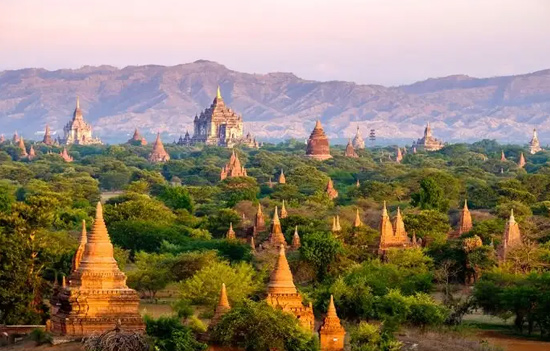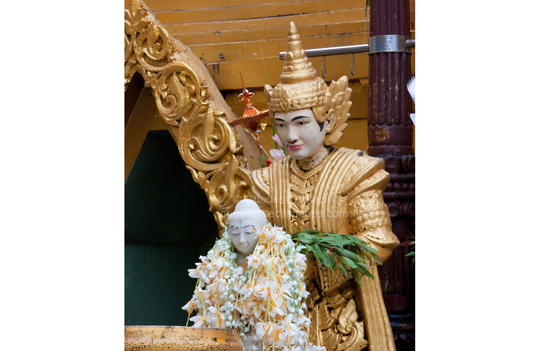- Know about the origins, design and evolution
of the Golden Pagoda in Burma.
On the hilltop, to the north of the old
Burmese capital, Yangon, is an edifice resembling a giant hand bell that gleams
with pure gold. Its central stupa, rising above a forest of spires of smaller
pagodas and pavilions like a great ship, is the most magnificent of all.
Covering an area of 14 acres, the pagoda is a complex of glittering pinnacles with strange and familiar creatures—golden leogriffs (half lion, half griffin), sphinxes, dragons, lions and elephants. Situated on the summit of the Singuttara Hill towering above the tranquil waters of the Royal Lake, it is paradise for the senses.
According to legend, at the end of the
previous kalpa, five lotus buds sprang up on Singuttara Hill. From each bud
arose a sacred bird carrying a sacred yellow robe. These
birds symbolise the five Buddhas who would appear in the present kalpa.
Four Buddhas, Kakusandha, Konagamana, Kassapa and Gautam have already lived and
the fifth, Maitreya, is still awaited before end of this kalpa. The special
association between Shwedagon and Buddhism explains the profusion of Buddha
effigies found in and around the pagoda. The pagoda has been sacred to
Buddhists for the last 2500 years.
This article was first published in the Bhavan’s Journal.
The history of Yangon is closely
associated with the Shwedagon Pagoda. Burma was known as Asitanjana or Okkala,
some five hundred years before the Christian era. In the 6th century BCE
Gautama encountered two merchants, Tapussa and Bhallika. Some historians
say, they were from Odisha while others say they were from Asitanjana. They fed
Buddha his first meal after enlightenment, comprising sweet cakes and honey.
Buddha presented them with eight strands
of his hair as a memento and they presented it to the King of Rangoon to be
kept in the Pagoda. The Pagoda is believed to contain relics of the
four previous Buddhas of the present kalpa: a staff
of Kakusandha, a piece of the robe of Kassapa, a water cup
of Konaagaman and the eight strands of hair from the head of Gautama.
At that time, the Pagoda was 20 m high
and the king consecrated it as the Shwedagon, the Reliquary of four. The hill
became a place of pilgrimage and the first notable visitor was King Ashoka in
260 BCE.
From 588 BCE to the 14th century,
Shwedagon was maintained by 32 kings of the Okkalapa dynasty and since 1372 CE,
by King Banyayan and his descendants. The Pagoda was enclosed by iron, marble,
tin, copper, lead and silver, each built over each other.
 Ancient capital of Bagan.
Ancient capital of Bagan.
This shrine has undergone several
modifications through the years. Since the 15th century, the temple complex has
grown with the addition of secondary structures, shrines and other monuments.
Queen Shinsawbu raised it to a height of 40 m and for the first time, gilded the stupa with gold equal to her own weight. Her son-in-law, King Dhammazedi was more generous, donating his and his queen’s weight in gold four times to re-plate the stupa.
In 1775, King Hsinbyushin had it rebuilt
to a height of 99 m. Because of the climate, the gold has to be re-plated every 20 years and it is now done through public donations. The king contributed further by putting up three stone tablets inscribed with the pagodas’ history in Burmese, Pali and Mon. He also donated a massive bell weighing 20 tonnes.
The present Maha
Gandha bell was donated by King Singu in 1779, which is housed in a separate
pavilion of the pagoda. The ornate prayer pavilions or tazoungs which surround
the main pagoda, abound with images of Buddha, many illuminated with flickering
candlelight.
The pagoda’s base is surrounded by 64 pagodas with four larger ones in the centre of each side. Its core is solid and not open to the public. Above the base are three terraces that can only be visited by monks. From the terraces up to the top, all the elements are golden and have seven angular projections between the main sides.
Facing the cardinal points, next rises
the bell-shaped superstructure followed by the dome in the form of an inverted
bowl. Then comes the multiple mouldings consisting of two bands of ornamental
lotus petals, divided by a ring of spherical bosses (Ywai). The spire, shaped
like a plantain bud, is topped by the hui (umbrella). The crown umbrella on top
is an invaluable structure embedded with thousands of precious stones.
Hundreds of golden bells are also attached to the umbrella.
With a height of 13 m and a diameter of
4.5 m at its broadest, it is encased in 500 kilos of gold with 83,850 varieties
of gemstones attached to it. The total weight is about 5000 kilos. From the hui
rises a gem[1]encrusted
vane topped by a golden orb studded with more than 1,100 diamonds, including
one of 76 carats on the tip and nearly 1,400 other precious stones consisting
of rubies, sapphires and diamonds.
The compound consists of the main stupa
and four gateways, each one guarded by statues of the mythological guardian
lions known as chinthes. The
southern approach is guarded by two huge leogryphs, 90 m high. In recent years,
three of them have been installed with elevators. On the platform are several
shrines and prayer halls, some of which are decorated with very fine wood
carvings and mosaic work. Eight small shrines are located on each of the eight
corners of the main stupa.
A different image of
Buddha is seen on each one, representing the seven days of the week. The
Wednesday image is split into two, one for the morning and one for the evening,
thus taking the total to 8.
Local people pray in the shrines
according to the day of their birth.
 Lord Brahma holding child.
Lord Brahma holding child.
Near the Saturday corner, there is a
figure of Brahma holding a child. It is said that praying before this figure grants the wishes of infertile couples for a child. The main stupa is the temple’s most impressive structure. It is visible at its hilltop location from most parts of Yangon city.
This article was first published in the Bhavan’s Journal, 15 March 2023 issue. This article is courtesy and copyright Bhavan’s Journal, Bharatiya Vidya Bhavan, Mumbai-400007. eSamskriti has obtained permission from Bhavan’s Journal to share. Do subscribe to the Bhavan’s Journal – it is very good.
Also see photo albums
1. Wats of
Bangkok
2. Sukothai
Historical Park, Thailand
3. Emerald
Buddha Temple, Bangkok
4. Bodh Gaya Temple
5. Great Buddha
Statue
6. Hindus
of Myanmar
7. A Guide to Myanmar’s ancient capital of Bagan